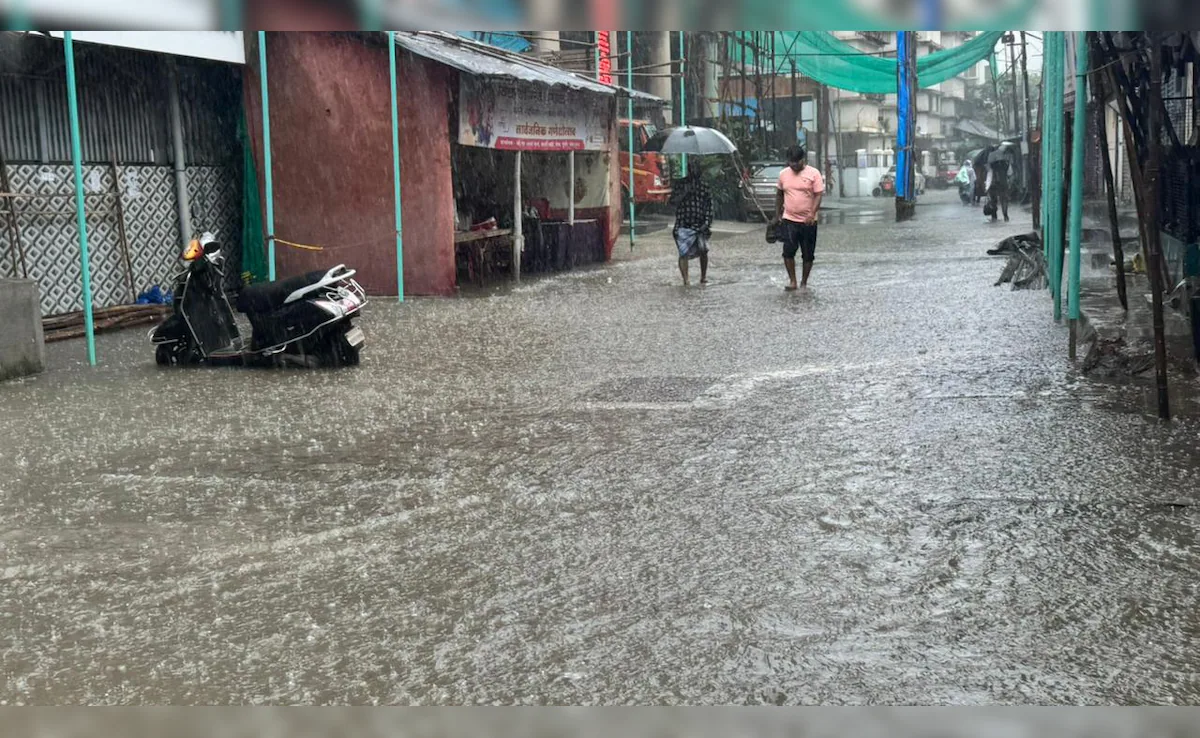Mumbai Faces Unprecedented Rainfall: Severe Weather Leads to School Closures and Traffic Chaos
Mumbai, the bustling metropolis known for its vibrant life and towering skyscrapers, is currently experiencing a significant weather crisis. On the morning of August 18, 2025, heavy rain swept through the city and its suburbs, leading to widespread waterlogging, severe traffic jams, and disruptions in local transportation, including flights. Government officials have declared a holiday for schools and colleges in a bid to ensure the safety of students and staff during this period of extreme weather.
The city has recorded alarming rainfall numbers, with over 54 mm falling in the last 24 hours alone. The eastern and western suburbs reported even higher figures, with 72 mm and 65 mm of rain, respectively. This adverse weather has compelled the Brihanmumbai Municipal Corporation (BMC) to issue a red alert, signifying “extremely heavy” rainfall in various parts of the city. As the situation escalates, local authorities and emergency services are mobilizing to assist citizens and mitigate the impact of the torrential downpour.
Among the key developments today, officials have urged residents to avoid unnecessary travel, emphasizing the importance of staying indoors. The relentless rain has resulted in significant waterlogging in regions such as Andheri, Lokhandwala, Kanjurmarg, and Sion Gandhi market. Major roads, including the Eastern Freeway and the Western Express Highway, have become virtual parking lots as vehicles remain stuck in the rising waters. Visuals circulating on social media depict a dire scene, with hundreds of vehicles stranded and commuters facing long wait times.
As per the report by Mumbai Mirror, the impact of the severe weather extends to air travel as well, with numerous flights experiencing delays and diversions. Notably, at least nine “go-arounds” were reported, a situation where pilots choose to abort a landing due to unsafe conditions. Coincidentally, an average delay of 54 minutes has been recorded for all flights departing from Chhatrapati Shivaji Maharaj International Airport.
Train services, the lifeline of Mumbai, have also been affected, with delays ranging from 15 to 20 minutes, according to various reports. The BMC is working actively to share updates on public transportation, especially for BEST buses, which have faced diversions due to waterlogged routes. Residents are encouraged to reach out to the BMC control room via the 1916 helpline for any emergencies.
In addition to the traffic and transportation issues, there have been reports of structural damage due to the heavy rain. A wall collapse occurred in Chembur, thankfully without any casualties. Emergency response teams from the BMC and the fire department have been deployed to the site to assist with evacuations and ensure the safety of those affected.
Impact of Monsoon on Daily Life and Infrastructure
The monsoon season has always been a double-edged sword for Mumbai. While it replenishes reservoirs and alleviates water shortages for the city’s population, it also exposes the inadequacies of urban infrastructure. Despite ongoing efforts by the government to improve drainage systems and other facilities, the city often finds itself grappling with the aftermath of heavy rains, leading to chaos and disruption.
Local businesses are now facing the brunt of the weather crisis, with many shops and restaurants forced to close their doors in light of the flooding and traffic snarls. The restaurant sector, which relies heavily on foot traffic, is particularly vulnerable during such adverse weather conditions. The economic aftermath could be significant if this weather pattern persists, as it will affect not only reduced sales but also employment.
Additionally, the logistics and supply chain management in the region will face challenges. Goods traveling in and out of the city will be delayed, affecting multiple aspects of life in Mumbai. As a result, the local economy could take a hit, prompting further discussions on the importance of resilient urban planning and infrastructure development.
What Lies Ahead for Mumbai Residents
As forecasts indicate continued rainfall for the upcoming days, Mumbai residents must stay vigilant and prepared for potential fallout from the storm. Authorities will need to implement measures that prioritize public safety, including traffic management and emergency response protocols.
Experts are calling for discussions around climate resiliency and urban planning, emphasizing the need to enhance Mumbai’s drainage systems and preparedness for natural disasters. The ongoing challenges pose an opportunity for the government and citizens alike to take a proactive approach toward building a stronger, more resilient city for the future.
While residents remain hopeful for a quick return to normalcy, the unpredictability of weather patterns exacerbated by climate change adds a layer of uncertainty. As the situation evolves, it is crucial for citizens to stay informed through official channels, including updates from the BMC and local news providers.
For more information about the ongoing weather situation and updates, residents can check BMC’s official website and follow local news networks closely. Engaging in community discussions and sharing real-time updates will also help individuals navigate through the chaos during these challenging times.
While Mumbai prepares to weather the storm, resilience and unity among its citizens will play a pivotal role in overcoming this crisis. The city has faced numerous challenges over the years, and as it stands against the elements today, the spirit of Mumbai’s residents remains steadfast.
DISCLAIMER
We have taken every measure to ensure that the information in this article and on our social media platforms is accurate, verified, and obtained from reliable sources. For feedback or complaints, please contact us at info@hamslive.com.


